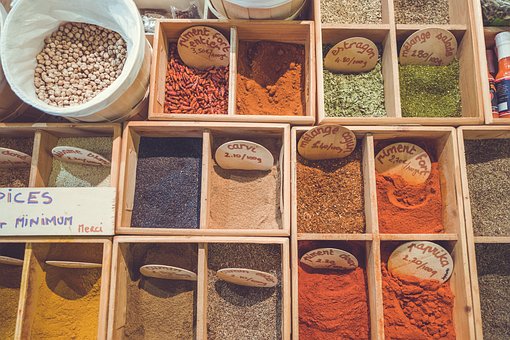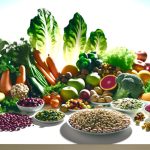A culture can be partially defined by the spices used in its cuisine. In India, there’s cardamom and cumin. In Italy, there’s basil and oregano. In Mexico, there’s chili, garlic, and cilantro. In Thailand, there’s lemongrass, sweet basil, and galangal.
There is a wide variety of food in North America due to the melting pot of cultures. What North America is most known for adding to the mix is its diversity. Not that North Americans don’t use spices. North American cuisine is not typically known for it’s own unique spices..
Herbs and spices travel the globe. You don’t have to live in Thailand to enjoy kaffir lime leaves. Or in Mexico to partake of green chilies. Herbs and spices just don’t create great flavors and wonderful food dishes they also provide healthy nutrition.
There are herbs and spices that are used to increase fertility, help with weight loss, boost your energy, fight infections and even help you sleep.
Cooking with herbs and spices is an art form. It is science to know which foods are especially good for you. Spices can make a difference in your kitchen and your health. Learning to use healthy spices can improve your cooking and your health.
Healthy Spices to Add Incredible Flavor and Health Benefits to Your Food
1. Turmeric
Turmeric is a spice that can be added to sauces, curries, stir-fries, and casseroles to add flavor.
The spice turmeric has been popular in India for more than 5,000 years. It is widely thought that turmeric is one of the primary reasons that India has one of the lowest rates of Alzheimer’s disease in the world.
Turmeric is known for its bright orange color. In fact, it’s sometimes used as a coloring agent. Curcumin, a polyphenol, is responsible for the orange color of the fruit and is considered a miracle compound. There is a large body of evidence to suggest that curcumin can help to prevent or even reverse Alzheimer’s and other forms of dementia, as well as reducing levels of inflammation, protecting against heavy metal toxicity, and reducing the risk of heart disease.
It is thought that people in India consume around 125mg of curcumin a day, which is the equivalent to half a teaspoon of turmeric powder.
Cancer rates are lower in countries where people eat a lot of curcumin.
If a half a teaspoon of turmeric is too much for you to stomach, you might want to consider a Curcumin supplement instead.
A study of adults over the age of 50 showed that those who consumed curcumin supplements over 18 months had improved memory test scores. They also reported being in better spirits. Most impressive? Their brain scans showed significantly fewer markers associated with cognitive decline.
Animal studies suggest that curcumin may have powerful anti-cancer properties. According to a study by Johns Hopkins University, a combination of curcumin and a chemotherapy drug is more effective at shrinking drug-resistant tumors than using chemotherapy alone.
If you’re looking to add a little extra flavor to your meal while also getting some great health benefits, consider adding turmeric to your diet. This spice has been shown to have a number of health benefits, including reducing inflammation and helping to prevent Alzheimer’s disease. This spice can be used in many different ways. You can rub it on roasted vegetables and meats, sprinkle it in tacos or create a curry.
Here’s a tip to get the most out of your turmeric: Combine it with black pepper and/or a healthy fat. This will help your body absorb the curcumin better.
2. Garlic
It can be used in savory or sweet dishes. Garlic can be chopped, minced, blended, or eaten as a powder and used in savory or sweet dishes. This herb is great in pasta sauces, soups, and most savory dishes.
Garlic is known for helping to keep away the bad guys. You can eat garlic to fight off certain cancers rather than hanging it over your doorway to scare away vampires.
The research studied the consumption of 127 foods by 41,387 Iowa women over five years. Garlic was found to most highly decrease colon cancer in a statistically significant way. Eating a lot of garlic reduces your risk of certain colon cancers by 50%.
A separate study of 5,000 men and women in China found that those who took a garlic extract had a 52% reduced risk of stomach cancer, compared to those who took a placebo.
Some people believe that garlic may help to fight colds and flu. But is this folklore backed up by real-world science? The researchers studied 146 participants, half of whom were given a garlic tablet and the other half a placebo tablet, every day for three months. The people who took the garlic reported only 24 colds. Those who took garlic were 20% more likely to recover from a cold than those who didn’t.
As you get older, it’s normal for your arteries to harden. The accumulation of fatty deposits on artery walls is known as atherosclerosis. These deposits are made up of cholesterol and other substances. There are a number of factors that can make heart disease worse, including smoking, high blood pressure and high cholesterol. As the build-up increases over time, the arteries narrow. You are more likely to have a heart attack or stroke if you have this condition.
The research showed that garlic has the ability to keep blood vessels flexible, especially in women. Multiple studies suggest that consuming garlic can help to reduce cholesterol and triglyceride levels.
Heart doctors often recommend eating a Mediterranean diet, which uses garlic as a key ingredient.
Garlic can be added to many different types of savory dishes. One meal tip is to combine fresh or powdered garlic with olive oil and pepper in order to add flavor to vegetables. Another meal tip is to use garlic with rosemary to make a tasty meat rub. You can also add it to soups and salad dressings.
Purium’s Revive It All is a scientifically combined proprietary blend of herbs and whole foods designed to help improve circulation, cognition, memory, and other age-related degeneration.
3. Ginger
Ginger is one of my favorite spices. It has a refreshing, clean, invigorating flavor. You can mix ginger powder or ginger tea with sparkling water and stevia to make a healthy ginger ale.
Ginger is a natural remedy for stomach issues like motion sickness, morning sickness, colic, upset stomach, irritable bowel syndrome, gas, diarrhea, nausea, and lack of appetite. It has potent anti-inflammatory properties. Some people find it useful in relieving pain caused by different types of arthritis and menstrual cramps.
Not only does ginger have all of these other benefits, but it has also been shown to be very effective in treating migraines.
If you’ve ever had a migraine, you know that it’s much more than just a headache. At least one billion people worldwide struggle with migraines that make everyday activities impossible. Migraines are estimated to cost the United States around $20 billion a year in direct and indirect costs.
However, could a natural remedy such as ginger be as effective as drugs, but with fewer side effects?
A clinical trial that was published in Phytotherapy Research in 2014 was double-blind and randomized. The researchers looked at a total of 100 people who were all experiencing moderate to severe pain because of migraines. The participants were split into two groups, with one group given a small amount of ginger powder and the other given a standard dose of sumatriptan. Most participants started out with moderate or severe pain. Some people reported feeling dizzy, sleepy, or like they’re spinning when taking sumatriptan. Others said they felt heartburn. The only downside to taking ginger was that a couple of participants reported an upset stomach. According to a review by 2020 Stephanie Nguyen Philadelphia College of Osteopathic Medicine: The addition of ginger did significantly decrease migraine pain 2h post-treatment. Ginger extract is an affordable supplement that is easily accessible
If you want to try the natural migraine remedy, mix 1/8 teaspoon of powdered ginger in water and drink it at the first sign of a migraine. If you have a headache, try drinking this and see if it goes away within half an hour.
The research found that ginger is effective at calming the nausea related to pregnancy and reducing the stomach upset after surgery. Some studies suggest that ginger may help to reduce the severity of motion sickness or prevent the symptoms altogether.
If you want to add some zingy spice to your diet, try adding ginger to stir-fry dishes, smoothies, or tea. This herb can also be used to add flavor to homemade salad dressings and baked goods.
4. Cinnamon
One of the most popular spices in the world, cinnamon is used in sweet and savory dishes for its warm, sweet flavor. Cinnamon is made from the inner bark of Cinnamomum trees. Cinnamon sticks are produced by drying strips of cinnamon bark, which causes them to curl. The sticks can also be ground into a powder.
This subtly flavoured spice can be used to enhance the flavour of drinks, baking, oatmeal, stir-fries and both savoury and sweet dishes.
Cinnamon has been used medicinally for thousands of years. It’s loaded with polyphenols and other antioxidants.
Cinnamon is an incredible spice with many benefits. It is an anti-inflammatory, antidiabetic, antimicrobial, anticancer, lipid-lowering, and cardiovascular-disease-lowering.
The health benefits of cinnamon extend to the heart by reducing high blood cholesterol and triglyceride levels. It is especially important for people with diabetes to take care of their heart health, as they are more likely to develop heart disease. Cinnamon is not a replacement for diabetes medication or a carbohydrate-controlled diet, but it can help regulate blood sugar levels when used in conjunction with these treatments.
A tip for meals: Try sprinkling cinnamon on yogurt, fruit or hot cereal, or use it in stews and chilis or as a meat rub.
Did you know that a sweet spice could have such a powerful healing effect?
READ MORE: Top 12 Cinnamon Health Benefits
5. Cayenne
Cultures where hot peppers like cayenne are used liberally have a much lower rate of heart attack, stroke, and pulmonary embolism. Cayenne has traditionally been used a heart tonic. Cayenne and other red chili peppers have been shown to reduce blood cholesterol, triglyceride levels, and platelet aggregation, while increasing the body`s ability to dissolve fibrin, a substance integral to the formation of blood clots.
A cayenne pepper is a type of chili pepper that is common in Southwestern American, Mexican, Creole, and Cajun cuisine. Cayenne peppers contain a substance called capsaicin. They are spicy because of the capsaicin and that is also what provides pain relief. Capsaicin blocks the pain signals that are sent to your brain. The result? You don’t register as much discomfort.
This medication is effective for treating pain that is caused by arthritis or nerve damage that is related to diabetes. Creams with capsaicin can be applied directly to joints and muscles.
Capsaicin, a substance found in spicy foods, can actually help to reduce the occurrence of ulcers. This is because capsaicin helps to restrict the growth of the bacteria that causes ulcers (Helicobacter pylori), and also helps to reduce excess stomach acid and increases blood flow. It may also help reduce the pain associated with ulcers.
If you want to add heat to your food, use this spice. It’s great in chili, soups, stews and on meat. To spice up your hot chocolate, add a dash of cayenne.
Healthiest Ways to Use Spices
The active compounds in spices are not affected by whether the spice is fresh or dried. The experts say that grilling or frying can reduce the antioxidants in spices, while cooking them in the microwave, simmering or stewing can actually increase the antioxidant levels.
Taking supplements to increase your dose of beneficial compounds is tempting, but it’s important to note that commercial supplements aren’t strictly regulated, so you can’t be certain what the pills actually contain. Some third-party organizations conduct testing to verify the quality and contents of supplements. Before you start taking any type of supplement, it is always a good idea to speak to your doctor or dietitian to make sure that it is the right form and amount for you.
Spices are not only healthy, but they also make food more delicious and can help you get out of an eating rut.
Eating food you enjoy is the key to maintaining healthy habits in the long term. It’s important to get medical advice before changing your diet.
Conclusion
Nutrition researchers say that there are more than 100 common spices used in cooking around the world, and some spices have been shown to be sources of antioxidants, which protect cells from damage.
There’s no need to look for rare and expensive spices – many of the best spices can be found in your local store.
The benefits of spices are most commonly seen when supplements are used to control the dose of the spice (or the spice’s active compound) that participants consume. They often provide doses that are bigger than what you would eat in a day.









